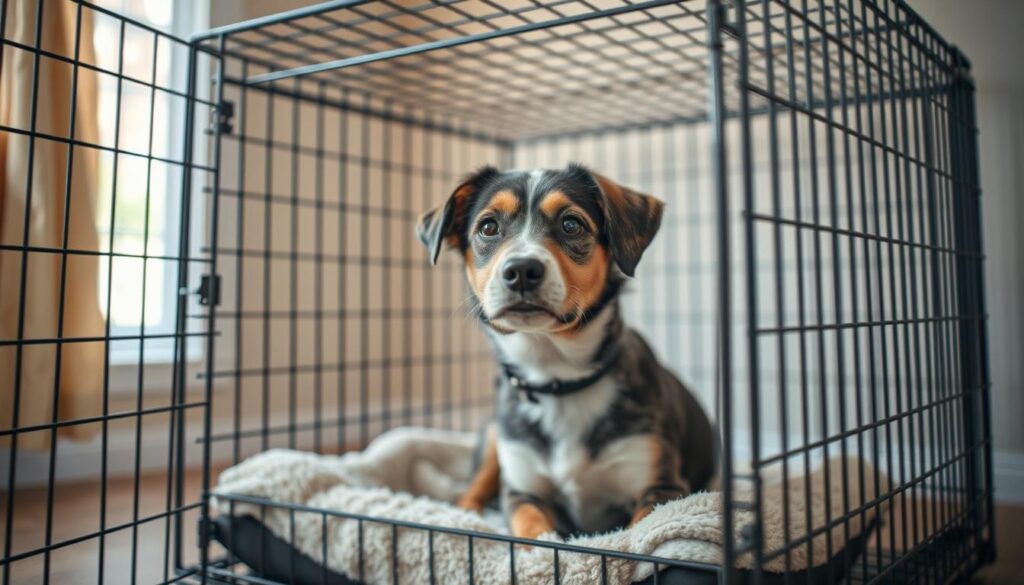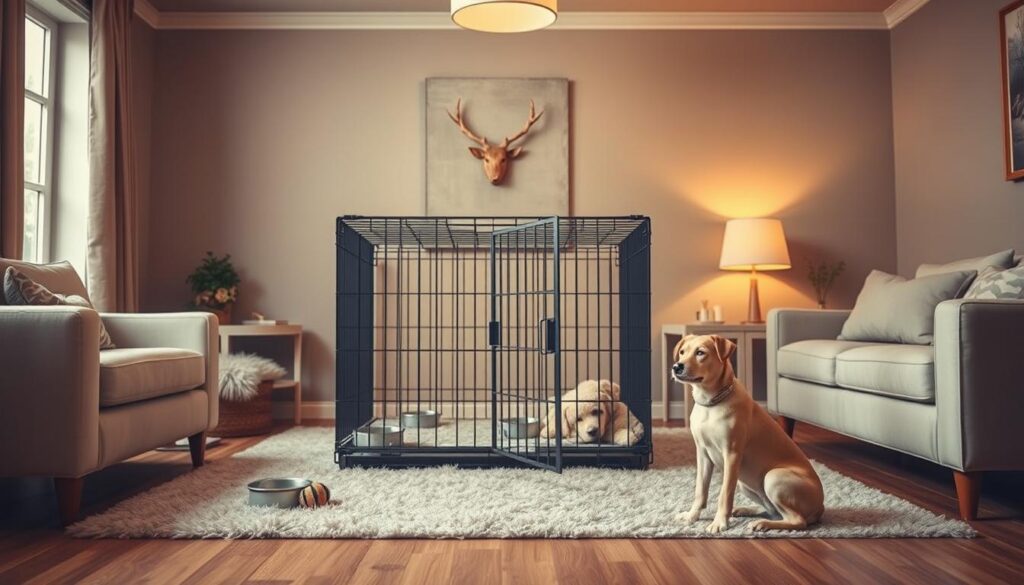Are you wondering if it’s possible to help your traumatized rescue dog feel secure in their new home?
Adopting a rescue dog can be a challenging yet rewarding experience. Many rescue dogs have suffered trauma, making it difficult for them to adjust to new environments.
This comprehensive guide will walk you through the process of crate training your dog gently and effectively. By understanding their specific needs and using positive reinforcement techniques, you can help your rescue feel comfortable and secure.
Key Takeaways
- Gentle crate training is possible for rescue dogs with past traumas.
- Understanding your dog’s specific needs is crucial for successful training.
- Positive reinforcement techniques build trust and create a positive association with the crate.
- Patience and consistency are key to helping your rescue dog adjust.
- A well-trained dog feels secure and develops healthy boundaries.
Understanding the Unique Challenges of Rescue Dogs
Rescue dogs often come with unique challenges that require patient and understanding owners. These challenges can stem from their past experiences, making it essential to provide a supportive environment.
As stated by the ASPCA, “Rescue dogs may have existing behavioral issues or anxieties that need to be addressed.” Crate training can play a significant role in helping these dogs feel secure and adjust to their new surroundings.
Common Behavioral Issues in Rescue Dogs
Rescue dogs may exhibit various behavioral issues due to their past traumas or lack of socialization. Common problems include anxiety, fear-based behaviors, and difficulty with house training. A safe space is crucial for helping them cope with these issues.
By providing a designated space for your dog, you can help alleviate some of these challenges. Crate training offers a structured approach to creating this safe haven.
Why Crate Training Benefits Rescue Dogs
Crate training benefits rescue dogs by giving them a sense of security and structure. It mimics the den-like environment that dogs naturally seek for safety, helping your rescue feel secure in your home.
- A crate provides a designated space that belongs solely to your dog, helping them decompress.
- It establishes boundaries and routines that help rescue dogs understand what to expect.
Selecting the Right Crate for Your Rescue Dog
The journey to successfully crate train your rescue dog begins with selecting the appropriate crate. This decision is crucial as it directly impacts your dog’s comfort and willingness to use the crate.
Types of Crates: Wire vs. Plastic
When it comes to choosing a crate, you’re often deciding between wire and plastic options. Wire crates offer better ventilation and visibility, which can be comforting for dogs that enjoy being able to see their surroundings. On the other hand, plastic crates provide a cozier, more den-like environment that can be particularly appealing to rescue dogs with anxiety.
For rescue dogs, either type can be suitable depending on the individual dog’s preferences and needs. It’s essential to consider factors such as your dog’s size, temperament, and any specific requirements they might have.
Finding the Perfect Size
Ensuring the crate is the right size for your dog is vital. The crate should be large enough for your dog to stand up, turn around, and lie down comfortably. A crate that is too small can be uncomfortable, while one that is too large may not provide the cozy, secure feeling that crate training aims to achieve.
Where to Place the Crate in Your Home
The placement of your rescue dog’s crate significantly impacts their comfort and willingness to use it. It’s recommended to place the crate in a quiet area of your home where family activities occur, allowing your dog to feel included while having their own space. Avoid high-traffic areas, direct sunlight, and proximity to heating or cooling vents.
Consider having the crate in your bedroom at night and in a family living area during the day. This helps your rescue dog feel connected to you while also giving them a quiet retreat when needed. For dogs with anxiety, placing the crate against a wall can provide an additional sense of security.
Preparing the Crate for Comfort and Security
Creating a cozy and secure crate environment is vital for your rescue dog’s well-being. A well-prepared crate helps in reducing anxiety and stress, making the crate training process smoother.
Bedding and Comfort Items
Providing comfortable bedding is essential for making the crate a welcoming space. You can add a soft blanket or a dog bed specifically designed for crates. Adding comfort items like a familiar scent or a favorite toy can also make the crate feel more like home.
Toys and Safe Chews for Crate Time
Toys and safe chews play a significant role in making crate time enjoyable. Durable puzzle toys filled with treats can keep your dog occupied, while safe chew toys like Kongs filled with frozen treats provide extended entertainment. It’s crucial to rotate toys regularly to maintain your dog’s interest and prevent boredom.
Some ideas for crate toys include:
– Durable puzzle toys filled with treats
– Safe chew toys like Kongs filled with frozen treats
– Toys with your scent for comfort during alone time
– Rotating toys to prevent boredom
The Gentle Approach to Crate Training a Rescue Dog
Crate training a rescue dog requires a thoughtful and compassionate approach. The key to successful crate training lies in creating a positive association with the crate through careful introduction and rewarding experiences. This method helps your dog view the crate as a safe and welcoming space.
Building Positive Associations
To build positive associations, introduce your dog to the crate gradually. Sit by the crate and call your dog over in a cheerful tone. Throw a treat or favorite toy just inside the crate. If your dog goes in and takes it, throw in another treat or two. This encourages them to enter the crate voluntarily. It’s essential to be relaxed and positive during this process, avoiding excessive praise that might make your dog feel nervous.
Key Tips for Building Positive Associations:
- Use high-value treats that your dog finds particularly motivating.
- Reward your dog immediately when they show interest in the crate or enter it voluntarily.
- Create a “treat trail” leading into the crate to encourage full entry.
- Pair verbal praise with treats to build a conditioned response.
Using Treats and Rewards Effectively
Treats and rewards are powerful tools in crate training, especially for rescue dogs who may be hesitant or fearful of confinement. Timing is crucial – reward your dog the moment they exhibit desired behavior. For especially hesitant dogs, consider using a clicker to mark desired behaviors precisely before delivering a treat. Gradually transition from continuous to intermittent rewards as your dog becomes more comfortable with the crate.
Some rescue dogs respond better to food rewards, while others prefer praise or play. Observe what motivates your dog most effectively and adjust your training approach accordingly. Never use treats to lure a frightened dog into the crate, as this can create distrust and setbacks in the training process.
Step 1: Introducing Your Rescue Dog to the Crate
A successful crate training process for rescue dogs starts with introducing the crate in a welcoming way. This initial step is crucial in setting a positive tone for the training process. It’s essential to make your dog feel comfortable and relaxed around the crate.
Creating a Welcoming First Impression
To create a positive first impression, place the crate in a high-traffic area of your home where your dog spends most of their time. Leave the crate door open, allowing your dog to explore it at their own pace. You can make the crate more inviting by adding comfortable bedding and a few treats inside. This encourages your dog to enter the crate voluntarily.

Allowing Exploration at Their Own Pace
Rescue dogs often need time to build trust with new environments, so it’s crucial to let them explore the crate without any pressure. Observe your dog’s body language carefully; signs of relaxation such as sniffing, wagging, and casual investigation indicate positive progress. You can create opportunities for your dog to discover treats or favorite toys inside the crate. Celebrate small victories, like looking inside the crate or placing one paw in, with quiet praise and reinforcement.
Continue this process until your dog goes into the crate happily and willingly. Using a command like “Kennel” or “Crate” helps your dog associate the command with the action. Reward your dog with treats and praise when they enter the crate voluntarily. By doing so, you’re building a positive association with the crate, making the training process smoother and more effective.
Step 2: Feeding Meals in the Crate
Once your rescue dog is comfortable eating inside the crate, it’s time to introduce the concept of door closure. This step is crucial as it helps your dog get used to the crate with the door closed, reducing the risk of anxiety or stress associated with confinement.
To start, gently close the door while your dog is eating, and then immediately open it when they finish their meal. With each subsequent meal, you can extend the time the door remains closed by a few seconds, always staying nearby to provide reassurance.
Gradually Moving Food Inside
As your dog becomes more comfortable with the door closing during meals, you can begin to move their food inside the crate. This gradual approach helps in building trust and making the crate a welcoming space. Watch your dog’s body language carefully; signs of relaxation indicate readiness to progress, while anxiety suggests slowing down.
Extending Time with the Door Closed
After your dog finishes eating, if they remain calm, you can offer additional treats through the crate bars to reward this behavior. The goal is to gradually extend the post-meal crating time to 5-10 minutes, ensuring your dog remains comfortable with each increment. Practice opening and closing the door quietly to prevent startling your rescue dog.
| Step | Action | Goal |
|---|---|---|
| 1 | Close the door while eating | Get dog used to door closure |
| 2 | Extend door closure time | Increase crating duration |
| 3 | Reward calm behavior | Positive reinforcement |
Step 3: Extending Crate Time When You’re Home
As you progress in crate training your rescue dog, it’s essential to extend the crate time gradually when you’re home. This step is crucial for helping your dog become comfortable with spending more time in the crate, both with you nearby and when you’re not in the same room.
Short Intervals with Positive Reinforcement
Begin by having your dog spend short intervals in the crate while you’re home. Use positive reinforcement techniques such as treats and praise to encourage good behavior. This approach helps your dog associate the crate with positive experiences.
Key tips for this stage include:
- Increasing crate time in small increments of 5-10 minutes.
- Observing your dog’s comfort level and adjusting the time accordingly.
- Practicing varying your distance from the crate.
Building Duration Gradually
As your dog becomes more comfortable with the crate, you can gradually increase the duration they spend inside. The goal is to leave your dog in the crate long enough for them to relax and lie down. Consistency is key; practice this several times a day.
| Duration | Your Action | Dog’s Expected Behavior |
|---|---|---|
| 5-10 minutes | Sit nearby, occasionally interact. | Relax, possibly lie down. |
| 10-15 minutes | Move around the room, sometimes leave the room briefly. | Remain calm, might get up but returns to lying down. |
| 15+ minutes | Leave the room for longer periods, return before anxiety sets in. | Relaxed, possibly sleeping. |
Success at this stage is indicated by your rescue dog voluntarily entering the crate and settling down comfortably. This gradual building of duration creates the foundation for longer crating periods when necessary.
Step 4: Crating While You’re Away
As you progress in crate training your rescue dog, it’s essential to introduce crating while you’re away from home. This step is critical in helping your dog adjust to being alone without developing separation anxiety. To achieve this, you need to prepare your dog for your departures and maintain a calm atmosphere during your arrivals and departures.
Preparing for Departures
To help your dog feel secure when crated while you’re away, it’s crucial to make your departures low-key. Avoid emotional goodbyes, as they can signal to your dog that something is amiss. Instead, practice “fake departures” where you leave briefly and return, gradually extending these periods to build your dog’s confidence. For dogs with severe anxiety, consider using calming aids like supplements or pheromone products as recommended by your veterinarian.

Keeping Arrivals and Departures Low-Key
When returning home, resist the urge to immediately release your dog or greet them excitedly, as this creates a stark contrast between being crated and being free. Instead, enter your home calmly, put away your belongings, and wait for your dog to calm down before opening the crate door. Continue to crate your dog for short periods when you’re home to prevent them from associating the crate with being alone. Consistency in your approach helps your rescue dog develop healthy expectations around crating and your absences, reducing the likelihood of anxiety when you’re away from home with the dog in the crate for a certain time.
Step 5: Nighttime Crating for Rescue Dogs
Rescue dogs often require extra care during nighttime crating due to potential anxiety issues. As they adjust to new surroundings and routines, it’s common for them to feel uneasy or scared at night. Establishing a comforting and secure environment is crucial for their well-being and successful crate training.
Creating a Comfortable Sleeping Environment
To help your rescue dog feel comfortable in their crate at night, start by placing it next to your bed. This proximity allows your dog to see and smell you, providing reassurance. A consistent bedtime routine that includes exercise earlier in the evening can also help your dog feel naturally tired at bedtime. Using a white noise machine or playing soft classical music can help mask unfamiliar household sounds that might trigger anxiety.
As your dog becomes more comfortable, you can gradually move the crate to its permanent nighttime location over several weeks. It’s essential to make this transition gradual to avoid causing additional stress.
Addressing Nighttime Anxiety
If your dog whines during the night, it’s crucial to determine the cause. “Is the whining due to the need to go to the bathroom, or is it an attempt to get out of the crate?” Initially, ignore the whining to gauge the dog’s intention. If the whining stops after a few minutes, it was likely attention-seeking behavior. However, if the whining persists, use the command you normally use to see if they need to go to the bathroom.
For dogs showing signs of severe nighttime anxiety, consulting your veterinarian about temporary calming aids can be beneficial. In some cases, a different sleeping arrangement might be more appropriate for their emotional needs. Nighttime comfort is essential for your rescue dog’s overall well-being and adjustment to their new home.
- Establish a consistent bedtime routine to help your dog feel tired at the right time.
- Consider using white noise machines or soft music to reduce anxiety triggered by household sounds.
- Gradually transition the crate to its permanent location to avoid causing additional stress.
Troubleshooting Common Crate Training Challenges
When it comes to crate training rescue dogs, it’s essential to anticipate and troubleshoot common challenges. Rescue dogs may have had negative experiences in the past, making crate training more complicated. Understanding these challenges is key to a successful training process.
Dealing with Whining and Barking
Whining and barking are common reactions to crate training. To address this, it’s crucial to ignore the behavior when it’s attention-seeking and reward calmness. Patience is vital; it may take some time for your dog to adjust. As one expert notes,
“Consistency and calm reactions from the owner are crucial in minimizing whining and barking.”
Addressing Separation Anxiety
Separation anxiety can manifest during crate training. To alleviate this, start by crating your dog for short periods while you’re still at home. Gradually increase the duration of your absence. Creating a calm environment can help reduce your dog’s stress.
Overcoming Fear of the Crate
Fear of the crate is particularly common in rescue dogs. Signs include freezing, backing away, or refusing to approach the crate. To overcome this fear, begin by placing treats near the crate and gradually move them closer over time. Never force your dog into the crate, as this can create lasting negative associations.
Conclusion: Patience and Consistency Are Key to Success
Patience and consistency are crucial when crate training a rescue dog. This process, while challenging, can lead to significant success with the right approach. By understanding your dog’s unique needs and past experiences, you can tailor your training method to their requirements.
Crate training is not a one-size-fits-all solution; it demands flexibility and a willingness to adapt. Celebrate small victories, as each positive step strengthens your bond with your rescue dog and helps them view their crate as a safe haven. With time and proper crate training, your dog can learn to not just tolerate but actually enjoy their crate.



